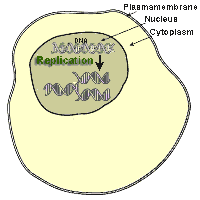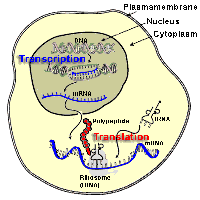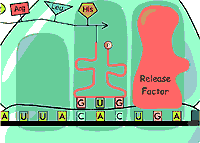| Complementary bases |
| Replication |
Transcription |
| DNA -> DNA | DNA -> RNA |
|
A -> T
T -> A
C -> G
G -> C
|
A -> U
T -> A
C -> G
G -> C
|
| A = Adenine, C = Cytosine, G = Guanine, T = Thymine, U = Uracil |
Replication is the process in which a cell makes an exact copy of its own DNA (copy DNA -> DNA). Replication occurs in the S-fase in preparation to cell division during which the genetic information for the synthesis of proteins is transfered from the mothercell to the daughtercell. Whether this cell division will eventually be a mitosis or a meiosis (
more on differences), in
either case during replication the entire DNA is copied in which the genetical code is encrypted as a sequence of nitrogenous bases.
The protein synthesis occurs by means of
transcrition (in the nucleus: production of RNA with nitrogenous bases that are complementary to one of the
DNA strands; thus DNA -> RNA) and
translation (in polyribosomes and the
rough endoplasmatic reticulum both located in the cytoplasm: RNA codes -> specific chains of aminoacids, i.e. polypeptide, the precursors of proteins). Proteins are involved in all vital functions in cells, including enzymatic catalyzation, transport, storage, movement, support, signaling,defence and control.
| Replication versus transcription/translation |
| Replication | Transcription + Translation |
|
DNA to DNA | Transcription: DNA to RNA
Tranlation: RNA to protein |
 |

|
| Click for a zoom of these illustrations; right image adapted from Talking Glossary of Genetics; permission for free use |
| Replication |
 |
During the S phase (S from synthesis), before cell division, DNA replication and control for errors of DNA takes place.
Replication begins with local decondensation and separation of the double DNA helices, so that the DNA molecule becomesaccessible for enzymes that make a complementary copy of each strand.
During replication a single chromosome is duplicated to form a double unit composed of two chromatides, attached together at the centromere. Depending whether a cell in interphase (see mitotic stages) is in the G1, S or G2 phase, it can thus carry unreplicated (single) chromosomes or -partially- replicated chromosomes (consisting of two chromatides).
|

Wikipedia open source
Credits: Mariana Ruiz Villarreal
|
|
Tip: start a Flash animation of the Bioplek (Dutch) on the structure of DNA and DNA replication |
| Transcriptie |
 The synthesis of new proteins begins with the transcription. DNA is transcribed to RNA to produce mRNA (messenger = Ribo Nucleic Acid), rRNA (ribosomal RNA) or tRNA (transport RNA). This happens in the nucleus by means of enzymatic complexes produced themselves by specific genes. The RNA is further transported outside the nucleus, to the cytoplasm, where it become active in the translation (the actual synthesis of proteins). During transcription the chromosomes are locally despiralized (decondensed), so that the genes present at this site ca be read. Only selective genes are in active state at a time. Two types of genes can be distinguished: 1) so-called "household genes" that are continually read and encode for products that are necessary for the metabolism and existance of a cell, and 2) genes that encode for specific products of importnace for cel differentiation. The activity of those lat genes (yes or not in state of transcription) is often determined by a confluence of external factors and internal cellular signals.
The synthesis of new proteins begins with the transcription. DNA is transcribed to RNA to produce mRNA (messenger = Ribo Nucleic Acid), rRNA (ribosomal RNA) or tRNA (transport RNA). This happens in the nucleus by means of enzymatic complexes produced themselves by specific genes. The RNA is further transported outside the nucleus, to the cytoplasm, where it become active in the translation (the actual synthesis of proteins). During transcription the chromosomes are locally despiralized (decondensed), so that the genes present at this site ca be read. Only selective genes are in active state at a time. Two types of genes can be distinguished: 1) so-called "household genes" that are continually read and encode for products that are necessary for the metabolism and existance of a cell, and 2) genes that encode for specific products of importnace for cel differentiation. The activity of those lat genes (yes or not in state of transcription) is often determined by a confluence of external factors and internal cellular signals.
|
|
Tip: start a Flash animation of the Bioplek (Dutch) on DNA transcription
|
|
| Translation |
 The translation follows the transcription up: in the cytoplasm, more precisely in ribosomes located in polyribosomalcomplexes or in the rough endoplasmatic reticulum, a rRNA unit binds a single-strand mRNA chain, which enhosts the genetic code as mirror of the DNA template. tRNA units carry aminoacids (each tRNA bindt to one specific aminoacid; there are 20 different amninoacid) to the ribosomes where they are coupled to form a polypeptide. The sequence and numbers of aminoacids is determined by the genetic code, consisting of three consequent mRNA bases (called triplets or mRNA codons; see tabel here right).
The translation follows the transcription up: in the cytoplasm, more precisely in ribosomes located in polyribosomalcomplexes or in the rough endoplasmatic reticulum, a rRNA unit binds a single-strand mRNA chain, which enhosts the genetic code as mirror of the DNA template. tRNA units carry aminoacids (each tRNA bindt to one specific aminoacid; there are 20 different amninoacid) to the ribosomes where they are coupled to form a polypeptide. The sequence and numbers of aminoacids is determined by the genetic code, consisting of three consequent mRNA bases (called triplets or mRNA codons; see tabel here right).
|
|
Numerous beautiful internet sites extend on the topic of translation and protein synthesis, e.g. the Dutch Bioplek and the Flash animations of the University of Utrecht, or the sfw film of the Ocean School of Hawaii.
|







